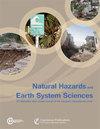Optimal probabilistic placement of facilities using a surrogate model for 3D tsunami simulations
IF 4.7
2区 地球科学
Q1 GEOSCIENCES, MULTIDISCIPLINARY
引用次数: 0
Abstract
Abstract. This study proposes a framework for utilizing results obtained from advanced numerical simulations and performing probabilistic tsunami hazard assessment for investigating optimal facility placement. A set of numerical simulations of the tsunami off the Pacific coast caused by the 2011 Tohoku earthquake are performed considering uncertainties in fault parameters. Both inundation depths and tsunami forces acting on buildings are numerically simulated and defined as tsunami hazard indices. Proper orthogonal decomposition is then applied to numerical results for extracting characteristic spatial modes, which can be used to construct surrogate models. Monte Carlo simulations (MCSs) were performed at a low computational cost using surrogate models. The optimal placement of facilities was probabilistically investigated with the help of genetic algorithms using the MCS results along with the concept of system failure probability. The results indicate that the proposed framework allows determining the optimal placement of facilities by applying different strategies at low computational costs while effectively reflecting the results of advanced tsunami simulations.使用替代模型进行三维海啸模拟的设施最佳概率布局
摘要本研究提出了一个框架,用于利用高级数值模拟的结果,并进行概率海啸危险评估,以调查最佳设施布局。考虑到断层参数的不确定性,对2011年东北地震在太平洋沿岸引发的海啸进行了一组数值模拟。对淹没深度和作用在建筑物上的海啸力进行了数值模拟,并将其定义为海啸危险指数。然后将适当的正交分解应用于数值结果,以提取特征空间模式,这些模式可用于构建代理模型。使用代理模型以低计算成本进行蒙特卡罗模拟(MCS)。利用MCS结果和系统故障概率的概念,借助遗传算法对设施的最佳布置进行了概率研究。结果表明,所提出的框架允许通过以低计算成本应用不同的策略来确定设施的最佳位置,同时有效地反映了高级海啸模拟的结果。
本文章由计算机程序翻译,如有差异,请以英文原文为准。
求助全文
约1分钟内获得全文
求助全文
来源期刊
CiteScore
7.60
自引率
6.50%
发文量
192
审稿时长
3.8 months
期刊介绍:
Natural Hazards and Earth System Sciences (NHESS) is an interdisciplinary and international journal dedicated to the public discussion and open-access publication of high-quality studies and original research on natural hazards and their consequences. Embracing a holistic Earth system science approach, NHESS serves a wide and diverse community of research scientists, practitioners, and decision makers concerned with detection of natural hazards, monitoring and modelling, vulnerability and risk assessment, and the design and implementation of mitigation and adaptation strategies, including economical, societal, and educational aspects.

 求助内容:
求助内容: 应助结果提醒方式:
应助结果提醒方式:


